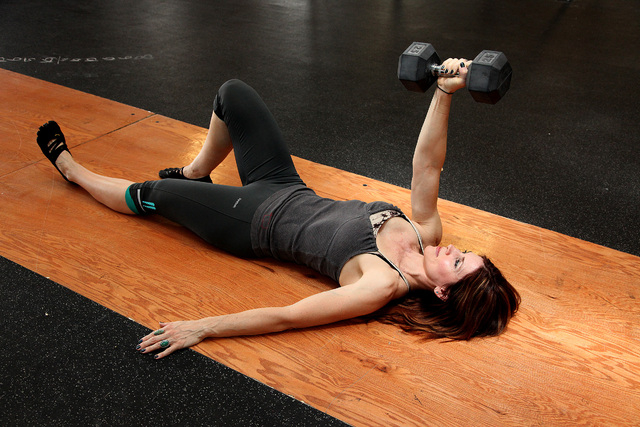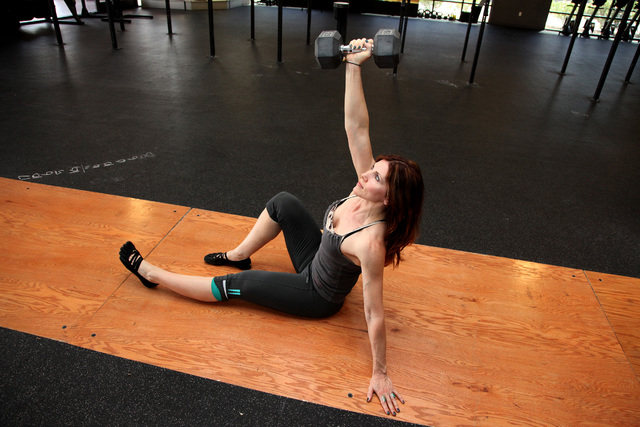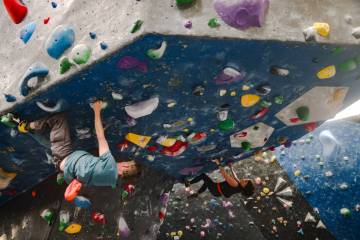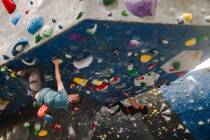Bells will be swinging, or hoisted, depending on goal
A while ago I got a good idea from a reader about a bells versus bells column. He was referring to kettlebells versus dumbbells and which is better.
For those unfamiliar with either bell, let me explain. Dumbbells are the traditional handle-type weights found in most gyms. Kettlebells look like a cannonball with a curve-shaped handle on top. Both bells range in size and weight.
I generally use kettlebells for total-body work because they are more awkward to handle than a traditional weight. This forces the body to adapt a more correct position when using them. From a trainer’s perspective, this is favorable because the athlete trains correct movement patterns under a controlled duress.
For example, one of the first movements anyone learns on a kettlebell is the kettlebell swing. (See my earlier columns on kettlebells at lvrj.com/trainer.) This requires the basic dead lift understanding just to get the bell into swing position. From there spinal awareness and hip extension mechanics are king. When lifted correctly, a weight you may think is heavy really is no problem.
Dumbbells make good workout gear for accessorizing primary movements. Movements such as presses and rows can be further developed by some effective dumbbell work focusing on the triceps, shoulders and lats. Breaking up dumbbell work into unilateral movements will go far in building a strong bar press or pull.
You can even use dumbbells for lower-body work. A standard dumbbell rack at your vacation or business trip hotel may not have the Superman equipment you are used to. This is where knowing a few dumbbell movements will come in handy so you are not forced to skip leg day. Dumbbell lunges, step-ups or thrusters are just a few that come to mind.
Whichever bell you prefer, I enjoy both pieces of workout equipment. Traditionally, I have used dumbbells for isolation work and kettlebells for total-body conditioning. However, you can substitute some kettlebell movements for dumbbell exercises and vice versa. Bell purists on both sides will argue differently. But in a pinch, weight is weight.
Today’s exercises can be done with ether bell. I recommend trying each out on your own to feel the difference.
Today’s weighted crunch is the precursor to a bear of a movement called the Turkish get-up, one of my favorite exercises that will never make it to the column because it’s complicatedly technical. The weighted crunch is valuable in teaching the core to stay aligned in the midst of holding weight overhead during a position change.
With a dumbbell, this exercise is fairly simple. A few things to keep in mind are the straight arm and spine. Notice in the photo that Laura Salcedo has a straight spine at the start and the end of the crunch. If the arm or the spine bends, then the power and force you once had will leave you and the weight will fall to the floor. Begin with a light dumbbell when you first try this exercise.
Moving this exercise to the kettlebell world, the bell is held in one hand and rests on the forearm. This position forces the wrist into a straight position, because the wrist starts to ache if it bends under a load. If you have trouble keeping the wrist straight, start with a lighter bell.
The movement to the seated position is the same. If you observe the video online at www.lvrj.com/trainer, Laura demonstrates the effective nature of the kettlebell. Without realizing it, her body puts her shoulder into a better position than with the dumbbell to accommodate the awkward shape of the kettlebell. I didn’t plan it that way, honest. Her body found a way to cheat with a familiar and even weighted dumbbell and was forced to be more engaged with an odd-shaped object.
There are some exercises that don’t really translate from one bell to the other. Bells are great for swinging your way into a fabulous posterior chain. Sure, you can swing a dumbbell but it’s not the same. You can’t swing as long and the grip on a large dumbbell will fatigue faster than an equally weighted kettlebell. Likewise, trying to do hammer curls or a Tate-press with a kettlebell will prove frustrating to say the least.
Maybe it is just the trainer in me, but I like both bells and when it comes down to it I use the tool that fits the task. But don’t take my word for it, try out today’s exercises and see for yourself.
Chris Huth is a Las Vegas trainer. He can be reached at 702trainer@gmail.com. Consult your physician before beginning any exercise program.



























